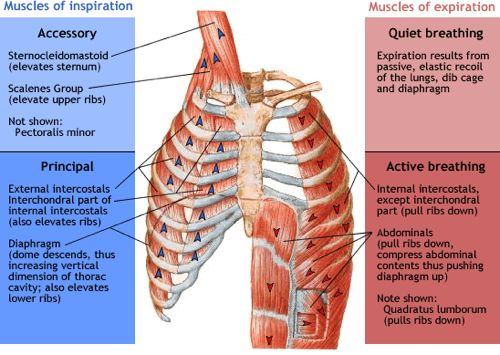The Primary Muscles Of Respiration Include The
A number of muscles are important for respiration. The primary muscles of respiration include the external intercostal muscles located between the ribs and the diaphragm a sheet of muscle located between the thoracic abdominal cavities.
File 79201024006 Posterior Trunk Muscles Posterior Trunk Muscles Trunk Muscles Muscles Of The Trunk Diagram Muscle Deltoids Trunks
The primary muscle involved in expiration is the diaphragm.

The primary muscles of respiration include the
. Click again to see term. The primary muscles of respiration include the Diaphragm and intercostals 8 A from NR 304 at Chamberlain College of Nursing. MUSCLES OF RESPIRATION Respiration involves Inspiration and Expiration which are accompanied by the alternate increase and decrease of the volume of thoracic cavity.Primary muscles of respiration Inspiratory muscles. Muscles of respiration Thoracic muscles. Muscles of Respiration.
The accessory muscles of inspiration include the scalenes SCM levator scapulae and. External obliques and pectoralis major. There are glands and mucus produced by goblet cells in parts as well as smooth muscle elastin or cartilage.
Click to see full answer. The muscles of respiration are those muscles that are necessary in order to reverse the pressure relationships for inspiration and expiration. Trapezius and rectus abdominis.
While the thoracic cage offers a resistant yet flexible framework it would be impossible for you to. The primary inspiratory muscles are the diaphragm and external intercostals. Posterior surface of xiphoid process.
The main muscles of respiration are the Diaphragm which forms the partition of the chest from the abdomen and the abdominal muscles. They appear to play a more important role in the intercostal muscles than in the diaphragm but muscle spindles do exist in both. Inspiration is an active process and is achieved by increase in all diameters of thoracic cavity.
Upper lumbar vertebrae L1-L3 w two crura. The secondary muscles involved in expiration include the internal and external intercostals external oblique internal oblique transverse abdoninal and rectus abdominis. Breathing out Usually passive relaxation only Forced expiration requires muscles Primarily in abdominal region Primary Muscles of Inhalation Diaphragm Intercostals between ribs External intercostals superficial Internal intercostals.
The respiratory muscles in common with other skeletal muscles have their tension controlled by a servo mechanism mediated by muscle spindles. Breathing is an active process - requiring the contraction of skeletal muscles. Muscles involved during inhalation of air from the environment include diaphragm and external intercostal muscle.
The primary muscles of respiration include the. Inner surface of ribs 7-12. Thoracic cavity has three diameters vertical transverse and anteroposterior.
The levatores costarum are primary muscles of respiration that probably serve mostly a proprioceptive role. The respiratory tract is covered in epithelium which varies down the tract. The main inspiratory muscles include the diaphragm external intercostal and scalene muscles with accessory muscles being the sternocleidomastoid pectoralis major and minor serratus anterior latissimus dorsi and serratus posterior superior.
By means of contraction they can actively increase the thoracic volume inspiration or decrease it expiration by passive relaxation. The external and internal intercostals do not work individually during breathing. However there are a few muscles that help in forceful expiration and include the internal intercostals intercostalis intimi subcostals and the abdominal muscles.
These are the muscles. Most of the epithelium from the nose to the bronchi is covered in ciliated pseudostratified columnar epithelium commonly called respiratory epithelium. Relaxed normal expiration is a passive process happens because of the elastic recoil of the lungs and surface tension.
Muscles Of Respiration Physiopedia
Muscles Of Respiration Physiopedia
Image Showing The Shape And Location Of The Diaphragm During Exhalation Diaphragmatic Breathing Yoga Anatomy Respiratory System
Sternocleidomastoid Pectoralis Major Pectoralis Minor Serratus Anterior
Inspiratory Muscle Training Human Respiratory System Respiratory System Human Body Systems
Muscles Of Respiration Physiopedia
Upper Respiratory Tract Respiratory System Human Anatomy And Physiology Respiratory System Anatomy





Post a Comment for "The Primary Muscles Of Respiration Include The"